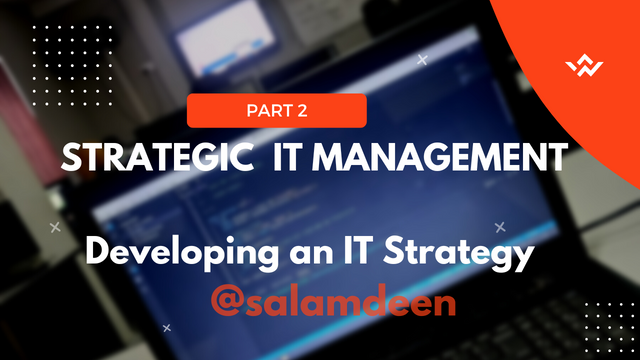
made with canva
Good day friends, this is part 2 of my strategic IT management series. In part 1, I discussed the introduction of Strategic IT management and its benefits to an organization. Today, I would like to discuss what it takes to develop an effective IT strategy for your organization. Developing an effective IT strategy is an essential part of managing any modern organization and achieving its goals and objectives.
Creating an IT strategy requires a thorough understanding of the organization's goals and objectives, an understanding of the scope and objectives of the IT strategy itself, an assessment of the resources available, and the ability to develop a strategic roadmap for implementation.
Understanding the organization's goals and objectives
The first step in developing an IT strategy is to gain a clear understanding of the organization's goals and objectives. This allows the IT team to align the IT strategy to the organization's overall mission and objectives. A comprehensive understanding of the organization's goals and objectives provides a context for the IT strategy and allows the IT team to develop specific initiatives and plans that support the organization's overall mission.
Defining the scope and objectives of the IT strategy
Once the IT team has a clear understanding of the organization's goals and objectives, the next step is to define the scope and objectives of the IT strategy. This includes outlining the goals of the IT strategy and the intended outcomes, as well as identifying any specific technologies or applications that must be included in the IT strategy. The scope and objectives of the IT strategy should be aligned with the organization's overall goals and objectives and should be designed to support the organization's mission.
Conducting a SWOT analysis
To ensure that the IT strategy is well-aligned with the organization's goals and objectives, it is important to conduct a thorough SWOT (Strengths, Weaknesses, Opportunities and Threats) analysis. A SWOT analysis can provide valuable insights into the organization's strengths and weaknesses, as well as identify any potential opportunities or threats that may impact the organization. By conducting a SWOT analysis, the IT team can gain a better understanding of the organization's current capabilities and develop an IT strategy that takes these into account.
Developing a strategic roadmap
Finally, once the IT team has gained a thorough understanding of the organization's goals and objectives, defined the scope and objectives of the IT strategy, and conducted a SWOT analysis, the next step is to develop a strategic roadmap for the IT strategy.
This roadmap should include a timeline for each initiative, as well as a plan for how the strategy will be implemented. It is important to ensure that the roadmap is well-aligned with the organization's overall goals and objectives and that it includes a detailed plan for the implementation of the IT strategy.
By developing a strategic roadmap, the IT team can ensure that the IT strategy is well-aligned with the organization's overall mission and can help to ensure the successful implementation of the strategy.
You can read more about the topic at opentrim.org- IT strategy management
